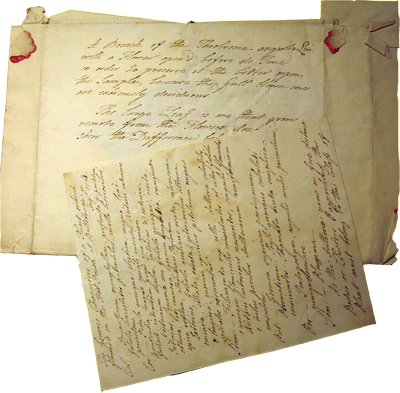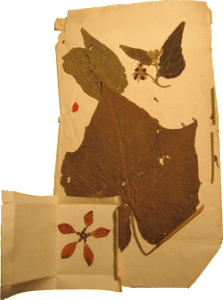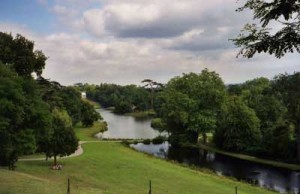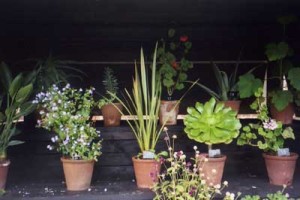Seed Packets and Their Stories

John Ellis in the English Enlightenment
The eighteenth century was an important period in the history of botanical transportation and transplantation. Imperial and commercial ventures opened up new worlds for natural discovery, and the influx of new plant specimens into Anglo-European cultures generated new ways of seeing and categorizing natural objects. A few summers ago, my interest in this eighteenth-century story led me to the Linnean Society of London, named for the great Swedish botanist-taxonomist Carl Linnaeus (1707-1778).
My research focused primarily on John Ellis (1710?-1776), a merchant, amateur naturalist, and avid experimenter who became a fellow of the Royal Society of London in 1754 and who made several contributions to the society’s Philosophical Transactions. The conservator at the Linnean Society had on her desk a box of miscellaneous Ellis materials waiting to be cleaned and properly conserved. Learning of my interest in Ellis, she allowed me to examine the contents of the box, which contained six folders. In each folder was a dried plant specimen wrapped up in paper and labeled: “Pimento or Jamaican Pepper called Allspice”; “Eugenia”; “Browniae”; “Ellisia—Linnai”; “Mynica cerafina—candle berry or myrtle [ ] tree”; “Chlamydia from New Zealand.”
The distribution of such dried samples was essential to the task of taxonomic classification, which preoccupied many naturalists in the eighteenth century. Indeed, Ellis corresponded with Linnaeus whose system of classification and development of binomial nomenclature made him the center of botanical taxonomy in the eighteenth century. The period is often characterized as driven by an imperialist tendency to break down the natural world into static, abstract units, and one way of understanding the classificatory impulse is to see it as a means to control and dominate. However, botanical objects have histories, and tracing some of these histories makes it harder to generalize about Enlightenment forms of producing and controlling knowledge of nature.
For example, one of the seed packets had the words “Theobroma augusta from the D & D of Portland” written on one side and, on the other side, “A branch of the Theobroma augusta with a flower open’d before its Time in order to preserve it the better upon the sample because the full blown ones are extremely deciduous. The large leaf is one that grows remote from

the flowers, design’d to show the difference between them” (figs. 1 and 2). Lying in the packet were a large leaf and some smaller ones, as well as a tiny folded packet showing the outline of a five-petalled flower inside (figs. 3 and 4). The following words were written on the outside of this smaller packet: “A flower of the Theobroma augusta full blown, taken out of the calyx & expanded. The Antherae may be seen between the Lobes of the [minor?] nectarium—one of the petals is unfortunately broken off.”
Along with the packet, the folder contained a sheet of paper with a character description of the plant, written in Ellis’s hand, titled “The Generic Characters of a Plant which flower’d in the Hot House in Bullstrode in August 1768” (fig. 5). Morphological character descriptions, an important component of systematic botany, outline each part or “character” of a botanical specimen, allowing naturalists to identify the specimen. Ellis’s character description of the “Theobroma augusta” concludes:
As the Antherae grow in five distinct Bodies or Clusters I apprehend this plant must belong to the Class of Polyadelphia, tho’ for want of visible filaments it is somewhat irregular. There is no known genus with which the characters agree, tho’ the Theobroma comes the nearest, as having a Nectarium; but this has a double Nectarium, a Calyx divided into five leaves & five styles & therefore it cannot properly be a Theobroma. It had the habit of an hibiscus & grew to the Height of 7 or 8 feet, & branching. It died after flowering.
Here was a glimpse of botanical work in progress. This dried specimen had engaged Ellis’s curiosity, and his writing reflects the effort of learning to look at a botanical object with an attention nurtured by empirical modes of analysis. Still, Ellis’s words point to the difficulties facing systematists in this period. Mobile botanical objects enlarged the world by making more plants available for analysis. This expansion excited and fueled naturalists, even as it was a constant struggle (especially in the realm of botany) to order the specimens and consolidate the information they presented.
The exceptions and uncertainties of the systematic process are written into Ellis’s empirical description of the “Theobroma augusta,” in his acknowledgement that the specimen is “somewhat irregular” as a member of the class of Polyadelphia and, most obviously, in the hesitation expressed in the grammar of the following sentence, which nevertheless strives to be true to empirical detailed observation: “There is no known genus with which the characters agree, tho’ the Theobroma comes the nearest, as having a Nectarium; but this has a double Nectarium, a Calyx divided into five leaves & five styles & therefore it cannot properly be a Theobroma.” In attending to the particulars of the material object, Ellis confronted the limits of observation and classification: even with the dried specimen before him, he was unable to determine its genus, and such uncertainty inhered in the Enlightenment classificatory project.
In addition to illustrating the analytical and rhetorical work of botanical classification, Ellis’s packet highlighted the expansiveness of the natural history community. Ellis’s comment that the Duke and Duchess of Portland were the source of the sample points to the role of patrons in the history of botanical collection. Ellis held these patrons in high regard, and at one point he tried (unsuccessfully) to have Linnaeus name a previously unnamed genus “Portlandia,” “after that eminent patroness of botany.” An interest in botanical objects allowed people to communicate across class differences and, in fact, had the power to collapse all sorts of distances between people, including geographical, educational, and social.
The mobility of plant specimens enabled them literally to collapse the distance between people and places. A seed packet was one mode of transport, and the history of botanical collection is inseparable from the history of travel and exploration. For example, Captain James Cook’s first voyage to the Pacific in HMS Endeavour (1768-1771) represents one of the touchstone moments of English imperial exploration, and Ellis’s seed packets offered a personal perspective on the aims and achievements of that voyage.
One of the large packets had the words “Chlamydia from New Zealand” written on the outside. I unfolded it and found that it was actually a sheet of newsprint containing “The Election List of the Royal Society MDCLLXXI (1771).” The packet contained some leaves, part of the flower stem, some seed pods, and a bit of woven cloth (fig. 6). As it happened, a botanist from the Natural History Museum in Londonwas working in the library that day. After examining the sample of “Chlamydia from New Zealand,” he declared it to be a sample of what is now called Phormium tenax, or New Zealand flax. The small piece of cloth, he said, was woven from the plant and was an example of one of its many uses, including the making of rope.
As I later learned, Ellis wrote a letter to Linnaeus on January 14, 1772, about his work with the “Chlamydia” specimens. Linnaeus had complained to Ellis in December of 1771 that he had not yet seen a single specimen from Cook’s Endeavour voyage. One of his favorite students, Daniel Solander (1733-1782), who had been living in London since 1760 as an assistant at the British Museum, served as a botanist on the expedition, and Linnaeus, feeling injured by Solander’s neglect, asked Ellis to intervene.
Ellis’s January letter reports that he fulfilled this obligation and provides further details of the voyage, before expressing a “hope [that] I shall be able, in the spring, to raise the seeds of a most valuable plant, which they call Chlamydia, from the people of New Zealand, in the latitude of 40 deg. South, making themselves cloaks of it.” Ellis describes the specific features of the plant and then writes, “As the seeds of it were all destroyed by the sunshine and bad weather, I begged Solander to let me look at the specimens which they had preserved in papers, and was so fortunate as to find several seed vessels perfectly sound and full of ripe seeds. I have got some of them from him, and given them to our best gardeners, and have examined them in the microscope, and find the germ in the seed perfectly sound.”
Ellis’s letter provides insight into the complex interpersonal relations that grounded the work of botanical collection and classification. Linnaeus, sitting at home in Uppsala while his students traveled all over the world collecting natural objects for him, could be quite peevish and demanding. Ellis’s letter suggests that he soothed the situation by bringing the wayward Solander into line. The letter was a dominant form of natural history writing in the eighteenth century, and one of its strengths was in negotiating interpersonal relationships and facilitating a productive, ongoing exchange of information.
Ellis’s letter also highlights the contingency of the work of botanical collection and classification—seeds could be “destroyed by the sunshine and bad weather” and luck alone determined whether transported seed vessels contained “ripe seeds.” Linnaeus’s urgent desire to see specimens from the voyage reflects his awareness of such contingencies, in his fear that the objects would be destroyed before they could be analyzed and described, before their information could be recorded in a more pubic and permanent way. As he wrote to Ellis, if Solander did not publish his “botanical discoveries,” the “collection may long remain in the British Museum, a prey to moths and other insects, and the fruit of so much care, labour, expense, and hazard, may share the lot of but too many human projects, to the grief of the whole world.” Such contingencies attended all aspects of botanical collection and classification.
The story of the dried sample of “Chlamydia” at the Linnean Society was thus connected to several histories: to the expansion of empire and the exploration of the South Seas; to evolving methods of seed collection, transport, and preservation; to a network of naturalists and gardeners, bound together by a desire to expand knowledge of the natural world for both use and delight; to personal relationships involving mutual obligation and responsibility; and to emerging ways of seeing and describing natural objects.
Before I left London, I visited Painshill Park, a landscape park in Surrey created between 1738 and 1773 by the Honorable Charles Hamilton, the fourteenth child of the sixth Earl of Abercorn. Hamilton took the information gleaned during his first European Grand Tour in 1725 and followed the trend toward a more naturalistic style when designing his 250-acre pleasure garden. During my visit, the park was running an exhibit called “American Roots,” designed to show how Hamilton capitalized on the transatlantic trade in botanical objects in developing plans for his new landscape park. The effects of this trade are visible in the landscape of Painshill Park, now almost fully restored to its eighteenth-century appearance (fig. 7). The American Roots exhibit presented many live specimens of plants that would have been sent by colonial collectors to their English correspondents. In wandering around the exhibit, I encountered a “Theater of Plants.” According to the guide, such theaters were a feature of eighteenth-century landscape design and “displayed treasured plants in a graduated arrangement similar to seats in a theater.” There, sitting in a pot on the second tier, was Phormium tenax—Ellis’s “Chlamydia from New Zealand” (fig. 8).
Botanical objects like Ellis’s seed packets collapse the distance between the past and the present. They illustrate the ways that the classificatory impulse was not only an example of the Enlightenment project to abstract and categorize the natural world in order to understand and dominate it, but was also connected to living objects and to curious, engaged individuals—individuals like John Ellis, who recorded his observations of “Theobroma augusta” and “Chlamydia” with painstaking care. Learning to look at how eighteenth-century naturalists themselves learned to look at plant specimens deepens our understanding of Enlightenment natural history endeavors. Tracing the various histories—personal, empirical, horticultural, imperial—attached to botanical objects illuminates the ways the project of eighteenth-century botanical collection and classification was driven by a process of fruitful contingency.
Further Reading:
The best way to trace the history of eighteenth-century botanical exchange is to read the letters of those engaged in the process. The Linnean Society of London contains wonderful resources on the subject, and I am grateful to the society for permission to quote from the seed packets (transcriptions are my own). The American Philosophical Society and the Historical Society of Pennsylvania also offer a collection of materials concerning transatlantic botanical exchange, especially the work of John Bartram.
Many letters are buried in archives, but letters of Ellis and Linnaeus, among several others, appear in the invaluable two-volume Selection of the Correspondence of Linnaeus and Other Naturalists from the Original Manuscripts, edited by James Edward Smith (London, 1821; Arno Press Reprint, 1978). To understand the colonial American context, readers should start with Edmund Berkeley and Dorothy Smith Berkeley, eds., The Correspondence of John Bartram, 1734-1777 (Gainesville, Fla., 1992). Several previously unpublished letters of Peter Collinson, an English merchant engaged in botanical exchange and Bartram’s primary London correspondent, appear in Alan Armstrong, ed.,“Forget not Mee & My Garden . . .”: Selected Letters of Peter Collinson, F.R.S., 1725-1768 (Philadelphia, 2002).
Readers interested in a general introduction to natural history endeavors in the eighteenth-century British world should examine two excellent collections of essays: Nicholas Jardine, James A. Secord, and Emma C. Spary, eds., Cultures of Natural History (Cambridge, 1996) and David Philip Miller and Peter Hanns Reill, eds., Visions of Empire: Voyages, Botany, and Representations of Nature (Cambridge, 1996).
To get a glimpse of some of the botanical objects collected by Joseph Banks and Daniel Solander during the Endeavour voyage, visit the Website of the Natural History Museum in London. The site contains information as well as illustrations by Sydney Parkinson (1745-1771), an artist who accompanied Banks on the expedition.
This article originally appeared in issue 8.4 (July, 2008).
Stephanie Volmer is the managing editor of Raritan Quarterly. She recently completed a dissertation at Rutgers University titled “Planting a New World: Letters and Languages of Transatlantic Botanical Exchange, 1733-1777.”

![Fig. 3. "A flower of the Theobroma augusta full blown, taken out of the calyx & expanded. The Antherae may be seen between the Lobes of the [minor?] nectarium—one of the petals is unfortunately broken off." Courtesy of the Linnean Society of London.](https://commonplace.online/wp-content/uploads/2016/01/8.4.Volmer.3-300x238.gif)




